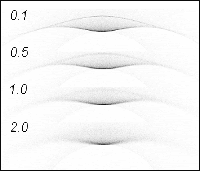
OPOD
What's New
Rays & Shadows
Water Droplets
Rainbows
Ice Halos
Contents
Crystals
Frequent Halos
Infrequent Halos
Why infrequent?
46° Halo
Supra/infralateral
Parry Arcs
Lowitz Arcs
Moilanen Arc
Kern Arc
120° Parhelia
44° Parhelia
Subhorizon Arcs
Pyramidal
Multiple Displays
Other Worlds
Observing Halos
HaloSim
High Atmosphere
Links & Resources
Search - Index
123456789012345678
| Infrequent Halos |
|
How infrequent are some halos?
The relative frequencies of halo sightings at right were calculated from 10 years of observations by the German Halo Research Group. In Europe a 22� halo occurs on about 100 days each year so dedicated sky watching might catch a Parry arc on average once a year. Visibility also depends on location, season and how much of the sky can be seen. Whatever, always search for rare halos whenever there are cirrus clouds. |
Halo 22� Parhelia Tangent arc Sun pillar Circumzenithal Parhelic circle Supralateral arc/46� halo 120� parhelia Parry arcs Pyramidal crystal halos All others |
Relative Frequency 100 73 27 16 13 4 4.2 1.2 1.1 0.3 1.5 |
Why are some halos infrequent? Why is the 46� halo seen much less often than the 22�?
| Crystal
quality. Cloud crystals
rarely attain gemlike perfection.
They have inclusions which impair halo clarity. Sometimes the
inclusions extend out to and damage crystal faces. Sometimes
the faces are imperfect anyway. These faults tend to impair
particular halos. For example, column crystal end faces
are most often imperfect thus blocking rays which would otherwise
form the 46� halo, infralateral and supralateral arcs.
Alignment & crystal size. Precise crystal alignment is needed for many halos. Large crystals (0.1mm or larger) are the best aligned but these are the most prone to imperfections. Large halos &
dispersed colours. Some halos are so large and their colours
so dispersed that they are inherently faint. Even if column crystals
had perfect end faces the 46� halo would always be at least six
times fainter than the 22�. |
The effects of imperfect alignment. At top right clear and distinct upper tangent and Parry arcs are formed by column crystals with tilts of only 0.1� std dev. As the crystal alignment becomes poorer the Parry arc becomes less and less distinct. With tilts over 1� it is hardly visible and even the Upper Tangent Arc is mediocre. |
 |